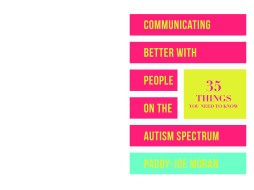
Additional Information
Book Details
Abstract
Covering verbal and non-verbal communication, Paddy-Joe Moran presents 35 simple tips and strategies to help professionals improve their communication and relationships with individuals on the autism spectrum.
The language that professionals choose to use can have a long-term impact on autistic people. This book provides easy-to-implement suggestions to guarantee effective and sensitive communication. It explains everything from person-first language through to the use of specific, rather than open-ended, questions, and a focus on taking the individual's lead with their preferred language and terminology is central to the book.
This helpful and accessible book challenges the assumption that only people with autism have problems with communication. Paddy-Joe Moran points out the numerous mistakes professionals can make in their interactions with autistic people, and offers helpful advice on how to make a positive difference with a small amount of effort and no extra cost. Tackling subjects from the use of labelling language to how to structure a conversation, and the importance of positivity and respect in all our interactions, this is a must read for all professionals.
Jane Forrest, Autism Support Coordinator, Cheshire and Wirral Partnership NHS Foundation Trust
Communicating Better with People on the Autism Spectrum is an excellent resource. Written from the perspective of autistic experience, Paddy-Joe Moran provides professionals working with those on the autism spectrum with a wealth of useful information on how to communicate in a respectful and inclusive manner. Information in the book will be invaluable in making working relationships between autistic people and professionals more productive and supportive.
Jeanette Purkis, autistic advocate and author of 'The Guide to Good Mental Health on the Autism Spectrum' and 'Finding a Different Kind of Normal'
Non-autistic professionals have strange ways of communicating. Sometimes they use inappropriate terminology, figures of speech, or rely excessively on gestures. It's not their fault. They just need guidance. They will benefit a great deal from reading this well-organised book and its bite-sized and easy-to-follow tips.
Janine Booth, author of 'Autism Equality in the Workplace: Removing barriers and challenging discrimination'
Paddy-Joe Moran was diagnosed with autism when he was eight. He is a writer and blogger and runs the online advice service Ask-Pergers?. Paddy-Joe co-authored Helping Children with Autism Spectrum Conditions through Everyday Transitions and Create a Reward Plan for your Child with Asperger Syndrome, both published by Jessica Kingsley Publishers. He is based in Manchester, UK.
Many of the strategies describe good practise for working with any individual, regardless of specific or additional needs... The main thrust of the book is that, as practitioner, we should remember that we are not treating a diagnosis but working with a child or young person, and the overall theme is of responding to the individuals we work with in a more compassionate and dignified manner.
Martin Edmonds
Special Children Magazine
Table of Contents
| Section Title | Page | Action | Price |
|---|---|---|---|
| Communicating Better with People on the Autism Spectrum - 35 Things You Need to Know by Paddy- Joe Moran | 1 | ||
| Introduction | 7 | ||
| Person-First Language – to Use it or Not? | 12 | ||
| Use Non-patronising Language | 15 | ||
| Use Age-appropriate Language | 18 | ||
| Use Neutral \nLanguage | 20 | ||
| Let Yourself Be Guided on Preferred Terminology | 23 | ||
| Don’t Use the Word ‘Normal’ | 27 | ||
| There is Nothing ‘Mild’ About Asperger’s Syndrome | 29 | ||
| Say ‘On the Spectrum’ | 32 | ||
| Address the Person Directly | 33 | ||
| Refer to Parents \nby Name | 35 | ||
| Adapting your Language and the Way you Speak | 37 | ||
| You Will be Taken Literally | 39 | ||
| Sarcasm | 41 | ||
| The Use of Functioning Labels | 43 | ||
| Non-verbal vs \nPre-verbal | 47 | ||
| Pre-conceived Ideas | 49 | ||
| Appearances can \nbe Deceptive | 51 | ||
| Triad of \nImpairments | 55 | ||
| Giftedness Is Not \na Given | 57 | ||
| Autism Is \na Neurological Condition | 60 | ||
| Autistic Person, \nNot Patient | 63 | ||
| No Need to Grieve | 65 | ||
| Puzzling | 67 | ||
| Facial \nExpressions | 69 | ||
| Body Language | 71 | ||
| Environment | 73 | ||
| Physical Contact | 75 | ||
| Have a Time Limit \non the Session | 77 | ||
| Offer Breaks During Sessions | 79 | ||
| Explain What Will \nbe Happening, \nand When | 82 | ||
| Stick to the Plan | 84 | ||
| Ask Specific Rather than Open-ended Questions | 86 | ||
| Pace your Speech | 88 | ||
| Alternatives to Non-verbal Communication | 90 | ||
| Things to Consider when Offering \nFood | 92 | ||
| Conclusion | 94 |
